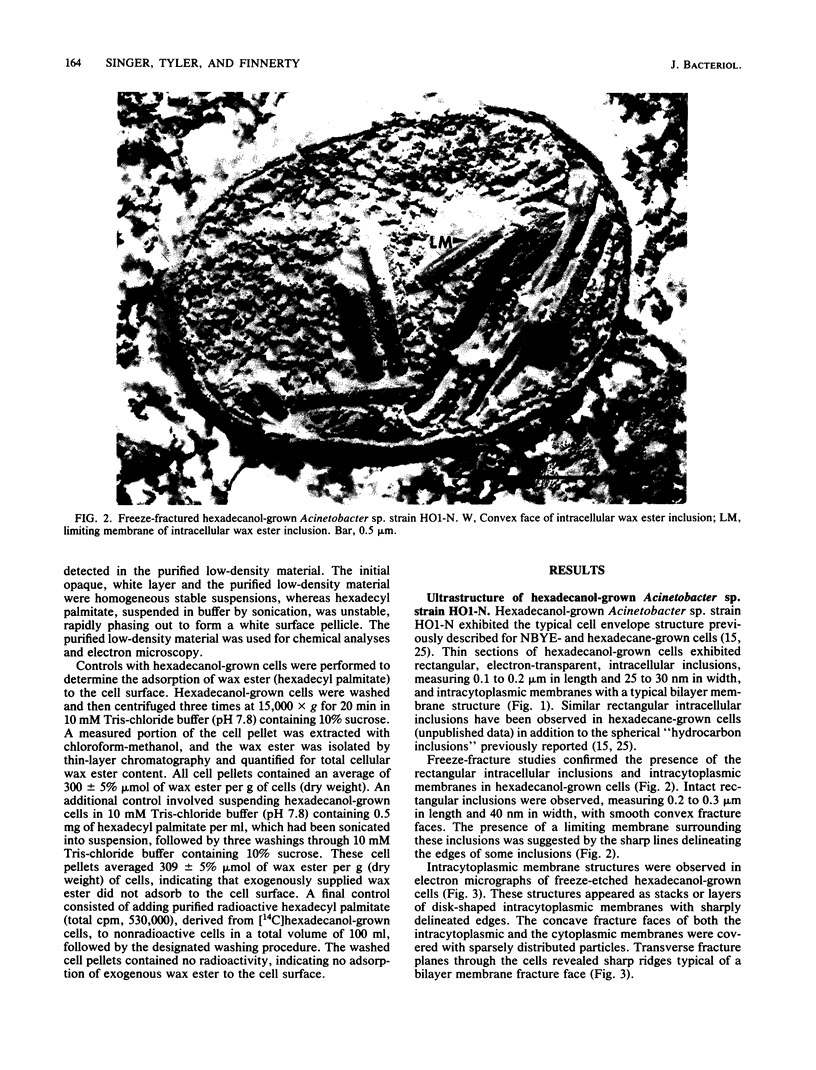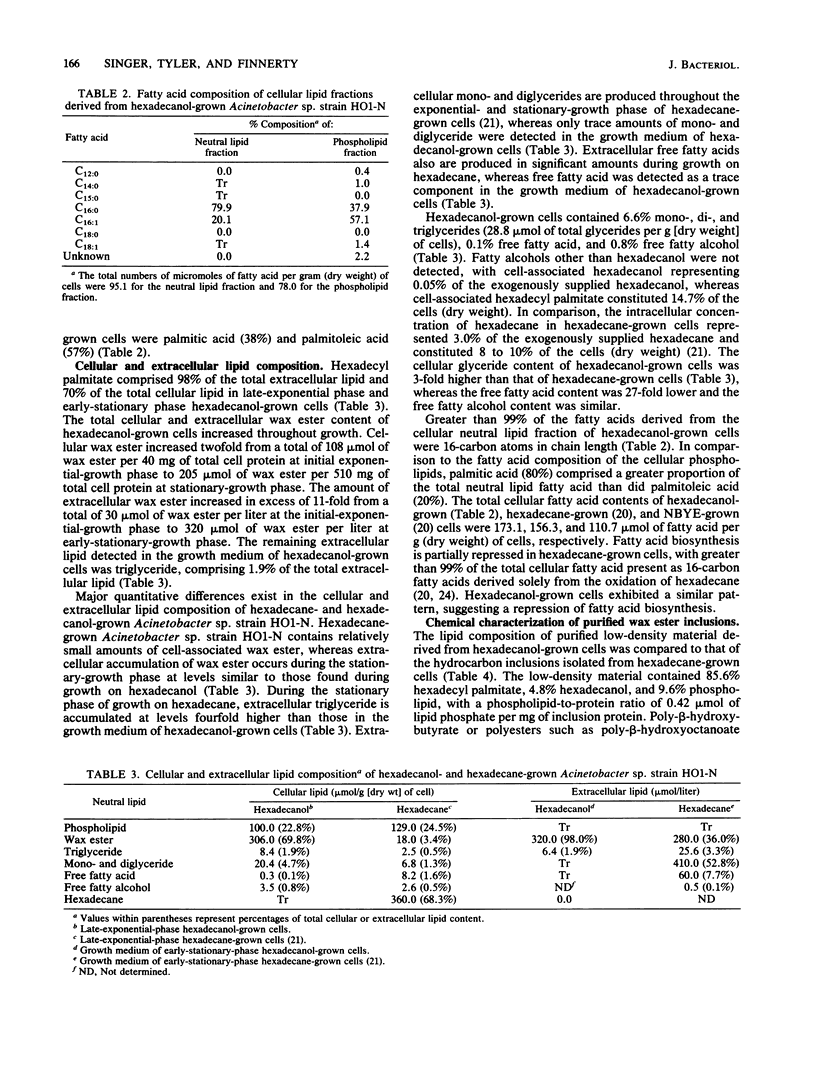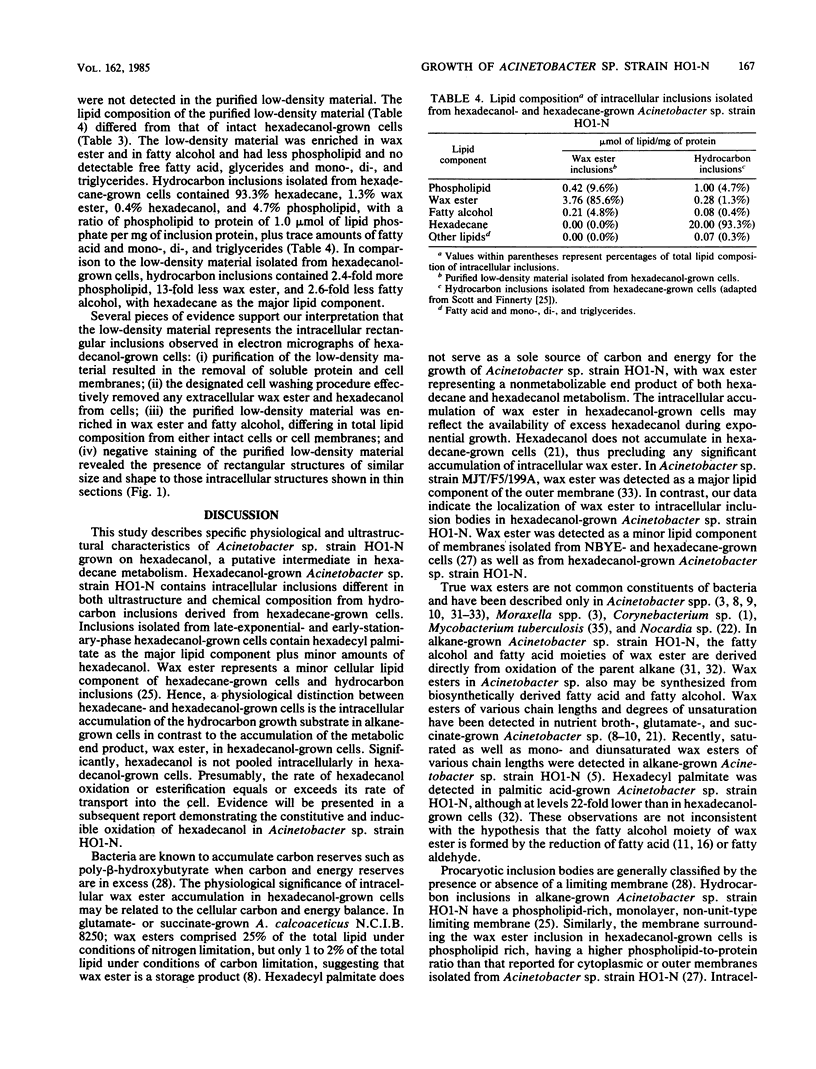Abstract
The growth of Acinetobacter sp. strain HO1-N on hexadecanol results in the formation of intracytoplasmic membranes and intracellular rectangular inclusions containing one of the end products of hexadecanol metabolism, hexadecyl palmitate. The intracellular inclusions were purified and characterized as "wax ester inclusions" consisting of 85.6% hexadecyl palmitate, 4.8% hexadecanol, and 9.6% phospholipid, with a phospholipid-to-protein ratio of 0.42 mumol of lipid phosphate per mg of inclusion protein. The cellular lipids consisted of 69.8% hexadecyl palmitate, 22.8% phospholipid, 1.9% triglyceride, 4.7% mono- and diglyceride, 0.1% free fatty acid, and 0.8% hexadecanol, as compared with 98% hexadecyl palmitate and 1.9% triglyceride, which comprised the extracellular lipids. Cell-associated hexadecanol represented 0.05% of the exogenously supplied hexadecanol, with hexadecyl palmitate accounting for 14.7% of the total cellular dry weight. Acinetobacter sp. strain HO1-N possesses a mechanism for the intracellular packaging of hexadecyl palmitate in wax ester inclusions, which differ in structure and chemical composition from "hydrocarbon inclusions" isolated from hexadecane-grown cells.
Full text
PDF







Images in this article
Selected References
These references are in PubMed. This may not be the complete list of references from this article.
- Bacchin P., Robertiello A., Viglia A. Identification of n-decane oxidation products in Corynebacterium cultures by combined gas chromatography-mass spectrometry. Appl Microbiol. 1974 Nov;28(5):737–741. doi: 10.1128/am.28.5.737-741.1974. [DOI] [PMC free article] [PubMed] [Google Scholar]
- Baumann P., Doudoroff M., Stanier R. Y. A study of the Moraxella group. II. Oxidative-negative species (genus Acinetobacter). J Bacteriol. 1968 May;95(5):1520–1541. doi: 10.1128/jb.95.5.1520-1541.1968. [DOI] [PMC free article] [PubMed] [Google Scholar]
- Bryn K., Jantzen E., Bovre K. Occurrence and patterns of waxes in Neisseriaceae. J Gen Microbiol. 1977 Sep;102(1):33–43. doi: 10.1099/00221287-102-1-33. [DOI] [PubMed] [Google Scholar]
- DITTMER J. C., LESTER R. L. A SIMPLE, SPECIFIC SPRAY FOR THE DETECTION OF PHOSPHOLIPIDS ON THIN-LAYER CHROMATOGRAMS. J Lipid Res. 1964 Jan;5:126–127. [PubMed] [Google Scholar]
- Fixter L. M., McCormack J. G. The effect of growth conditions on the wax content of various strains of Acinetobacter. Biochem Soc Trans. 1976;4(3):504–505. doi: 10.1042/bst0040504. [DOI] [PubMed] [Google Scholar]
- Gallagher I. H. Occurrence of waxes in Acinetobacter. J Gen Microbiol. 1971 Oct;68(2):245–247. doi: 10.1099/00221287-68-2-245. [DOI] [PubMed] [Google Scholar]
- Hankin L., Kolattukudy P. E. Metabolism of a plant wax paraffin (n-nonacosane) by a soil bacterium (Micrococcus cerificans). J Gen Microbiol. 1968 May;51(3):457–463. doi: 10.1099/00221287-51-3-457. [DOI] [PubMed] [Google Scholar]
- Kennedy R. S., Finnerty W. R. Microbial assimilation of hydrocarbons. II. Intracytoplasmic membrane induction in Acinetobacter sp. Arch Microbiol. 1975;102(2):85–90. doi: 10.1007/BF00428350. [DOI] [PubMed] [Google Scholar]
- Kolattukudy P. E. Biosynthesis of surface lipids. Biosynthesis of long-chain hydrocarbons and waxy esters is discussed. Science. 1968 Feb 2;159(3814):498–505. doi: 10.1126/science.159.3814.498. [DOI] [PubMed] [Google Scholar]
- Käppeli O., Finnerty W. R. Partition of alkane by an extracellular vesicle derived from hexadecane-grown Acinetobacter. J Bacteriol. 1979 Nov;140(2):707–712. doi: 10.1128/jb.140.2.707-712.1979. [DOI] [PMC free article] [PubMed] [Google Scholar]
- LOWRY O. H., ROSEBROUGH N. J., FARR A. L., RANDALL R. J. Protein measurement with the Folin phenol reagent. J Biol Chem. 1951 Nov;193(1):265–275. [PubMed] [Google Scholar]
- Makula R. A., Finnerty W. R. Microbial assimilation of hydrocarbons: cellular distribution of fatty acids. J Bacteriol. 1972 Oct;112(1):398–407. doi: 10.1128/jb.112.1.398-407.1972. [DOI] [PMC free article] [PubMed] [Google Scholar]
- Makula R. A., Finnerty W. R. Microbial assimilation of hydrocarbons: identification of phospholipids. J Bacteriol. 1970 Aug;103(2):348–355. doi: 10.1128/jb.103.2.348-355.1970. [DOI] [PMC free article] [PubMed] [Google Scholar]
- Makula R. A., Lockwood P. J., Finnerty W. R. Comparative analysis of the lipids of Acinetobacter species grown on hexadecane. J Bacteriol. 1975 Jan;121(1):250–258. doi: 10.1128/jb.121.1.250-258.1975. [DOI] [PMC free article] [PubMed] [Google Scholar]
- Makula R., Finnerty W. R. Microbial assimilation of hydrocarbons. I. Fatty acids derived from normal alkanes. J Bacteriol. 1968 Jun;95(6):2102–2107. doi: 10.1128/jb.95.6.2102-2107.1968. [DOI] [PMC free article] [PubMed] [Google Scholar]
- RAYMOND R. L., DAVIS J. B. n-Alkane utilization and lipid formation by a Nocardia. Appl Microbiol. 1960 Nov;8:329–334. doi: 10.1128/am.8.6.329-334.1960. [DOI] [PMC free article] [PubMed] [Google Scholar]
- REYNOLDS E. S. The use of lead citrate at high pH as an electron-opaque stain in electron microscopy. J Cell Biol. 1963 Apr;17:208–212. doi: 10.1083/jcb.17.1.208. [DOI] [PMC free article] [PubMed] [Google Scholar]
- SNYDER F., STEPHENS N. A simplified spectrophotometric determination of ester groups in lipids. Biochim Biophys Acta. 1959 Jul;34:244–245. doi: 10.1016/0006-3002(59)90255-0. [DOI] [PubMed] [Google Scholar]
- STEWART J. E., KALLIO R. E. Bacterial hydrocarbon oxidation. II. Ester formation from alkanes. J Bacteriol. 1959 Nov;78:726–730. doi: 10.1128/jb.78.5.726-730.1959. [DOI] [PMC free article] [PubMed] [Google Scholar]
- Sampson K. L., Finnerty W. R. Regulation of fatty acid biosynthesis in the hydrocarbon oxidizing microorganism, Acinetobacter sp. Arch Microbiol. 1974;99(3):203–220. doi: 10.1007/BF00696235. [DOI] [PubMed] [Google Scholar]
- Scott C. C., Finnerty W. R. A comparative analysis of the ultrastructure of hydrocarbon-oxidizing micro-organisms. J Gen Microbiol. 1976 Jun;94(2):342–350. doi: 10.1099/00221287-94-2-342. [DOI] [PubMed] [Google Scholar]
- Scott C. C., Finnerty W. R. Characterization of intracytoplasmic hydrocarbon inclusions from the hydrocarbon-oxidizing Acinetobacter species HO1-N. J Bacteriol. 1976 Jul;127(1):481–489. doi: 10.1128/jb.127.1.481-489.1976. [DOI] [PMC free article] [PubMed] [Google Scholar]
- Scott C. C., Makula S. R., Finnerty W. R. Isolation and characterization of membranes from a hydrocarbon-oxidizing Acinetobacter sp. J Bacteriol. 1976 Jul;127(1):469–480. doi: 10.1128/jb.127.1.469-480.1976. [DOI] [PMC free article] [PubMed] [Google Scholar]
- Shively J. M. Inclusion bodies of prokaryotes. Annu Rev Microbiol. 1974;28(0):167–187. doi: 10.1146/annurev.mi.28.100174.001123. [DOI] [PubMed] [Google Scholar]
- Thorne K. J., Thornley M. J., Glauert A. M. Chemical analysis of the outer membrane and other layers of the cell envelope of Acinetobacter sp. J Bacteriol. 1973 Oct;116(1):410–417. doi: 10.1128/jb.116.1.410-417.1973. [DOI] [PMC free article] [PubMed] [Google Scholar]
- Wang L., Takayama K., Goldman D. S., Schnoes H. K. Synthesis of alcohol and wax ester by a cell-free system in Mycobacterium tuberculosis. Biochim Biophys Acta. 1972 Jan 27;260(1):41–48. doi: 10.1016/0005-2760(72)90072-0. [DOI] [PubMed] [Google Scholar]
- de Smet M. J., Eggink G., Witholt B., Kingma J., Wynberg H. Characterization of intracellular inclusions formed by Pseudomonas oleovorans during growth on octane. J Bacteriol. 1983 May;154(2):870–878. doi: 10.1128/jb.154.2.870-878.1983. [DOI] [PMC free article] [PubMed] [Google Scholar]





